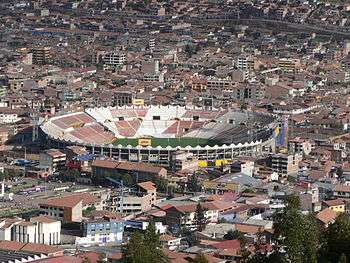Cienciano
 | |||
| Full name | Club Sportivo Cienciano | ||
|---|---|---|---|
| Nickname(s) | Los Rojos, Los Imperiales, La Furia Roja, Los Cuzqueños, El Papá | ||
| Founded | 8 July 1901 | ||
| Ground |
Inca Garcilaso de la Vega Cusco, Peru | ||
| Capacity | 42,056 | ||
| Chairman |
| ||
| Manager |
| ||
| League | Peruvian Segunda División | ||
| 2015 | Torneo Descentralizado, 15th | ||
| Website | Club home page | ||
|
| |||
Club Sportivo Cienciano is a professional football club based in Cusco, Peru. The club was founded in 1901 and was originally the team of the Faculty of Science of the University of Cusco (Ciencias meaning science in Spanish), from which it takes its name. It gained worldwide recognition after defeating River Plate from Argentina in the finals of the 2003 Copa Sudamericana and Boca Juniors in the 2004 Recopa Sudamericana.
History
Beginnings
Cienciano was founded in 1901 by a group of students from the National School of Science of Cusco (Colegio Nacional Ciencias del Cusco). It participated in several leagues and tournaments of the region. In 1966 Hector Ladrón de Guevara (Cututtu) was the first Cienciano player to be named captain of the Peruvian national team. In 1972, it began to play in the Peruvian First Division. However, the club was relegated four years later.
In 1988, the FPF invited the club to play in a tournament of the southern region. In 1991, Cienciano won the tournament and in 1992 it once again played in the First Division. Although the club came close to relegation in 1994, the team remains in the First Division.
Copa Sudamericana
In 2003 Cienciano, led by their coach Freddy Ternero, made it for the first time to the Copa Sudamericana, after beating the current Peruvian champion Sporting Cristal in an internal qualifying tournament. It went through every later knockout round arguably as the underdog defeating Peru's Alianza Lima, Chile's Universidad Católica, Colombia's Atlético Nacional (once Copa Libertadores champion) and Brazil's Santos (twice Copa Libertadores champion), to get to the finals. Once at the finals they faced one of the biggest teams in South American football, River Plate of Argentina (twice Copa Libertadores champion). After a 3–3 draw in Buenos Aires, Cienciano went on to win 1–0 on their home game in Peru with a goal from a free kick by Paraguayan defender Carlos Lugo. The game was played in Arequipa (home of Southern Peruvian rivals Melgar, some of whose fans actually attended the match to root for River Plate) because of the insufficient capacity for a CONMEBOL final of the Estadio Garcilaso (which has been expanded since then).
This was the first international championship for a Peruvian team in history, only two other Peruvian teams had advanced to the finals of an international tournament, the Copa Libertadores (Universitario in 1972, and Sporting Cristal in 1997) and was defeated. However, Cienciano had never won the Peruvian national champion (they did win one half-year tournament in 2001 but lost the title of national champions by a penalty shootout to the winner of the second tournament, Alianza Lima, in the year in which both celebrated their centenary. The situation was repeated in 2006 to the inverse: Cienciano won the second tournament but lost the final to Alianza Lima on aggregate).
Recopa Sudamericana
After winning the Copa Sudamericana, Cienciano went on to play against Boca Juniors of Argentina, another South American giant, for the 2004 Recopa Sudamericana, this being just one match, much like UEFA's European Super Cup, that faced the winner of both South American Cups of the previous season: the Copa Sudamericana and the Copa Libertadores. After a 1–1 draw, Cienciano went on to win the title by penalty shootout. The match was played in Fort Lauderdale, Florida.
Rivalries
Cienciano has had a long-standing rivalry with Melgar and Deportivo Garcilaso.
Stadium
Cienciano play their home games in Estadio Garcilaso de la Vega which is in Cusco. It was named after the Peruvian Inca Garcilaso de la Vega. When first inaugurated in 1950, it had a spectator capacity of 22,000 and had a running track. In 2004, the stadium's capacity was expanded to 42,000, losing its running track, because of Cienciano's success in international tournaments and it would be a venue in the 2004 Copa América.

Honours
National
- Copa Perú: 0
- Runner-up (1): 1973
Regional
- Winners (29): 1903, 1912, 1913, 1914, 1915, 1924, 1927, 1928, 1929, 1931, 1936, 1944, 1945, 1948, 1952, 1954, 1955, 1956, 1959, 1961, 1962, 1964, 1965, 1966, 1967, 1968, 1972, 1981, 1983
International
- Winners (1): 2003
- Winners (1): 2004
Friendly National
- Copa Callao: 0
- Runner-up (1): 2007
Performance in CONMEBOL competitions
- Copa Libertadores: 6 appearances
- 2002: Round of 16
- 2004: First Round
- 2005: Preliminary Round
- 2006: Second Round
- 2007: Second Round
- 2008: Second Round
- Copa Sudamericana: 3 appearances
- 2003: Winner
- 2004: Preliminary Round
- 2009: Round of 16
- Recopa Sudamericana: 1 appearance
- 2004: Winner
Current squad
- As of 2016
Note: Flags indicate national team as defined under FIFA eligibility rules. Players may hold more than one non-FIFA nationality.
|
|
Notable players
|
- Template:Country data Brazilia Ronaldinho
Managers
|
|
See also
References
External links
| Wikimedia Commons has media related to Cienciano. |